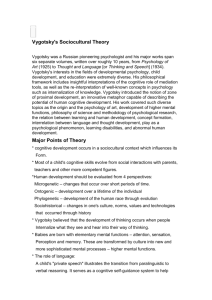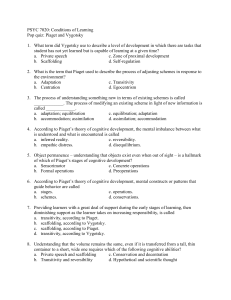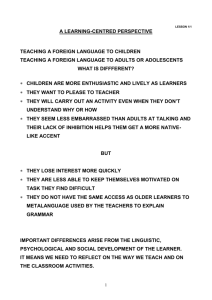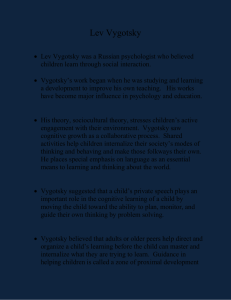Social Interaction and the CLD Learner
advertisement
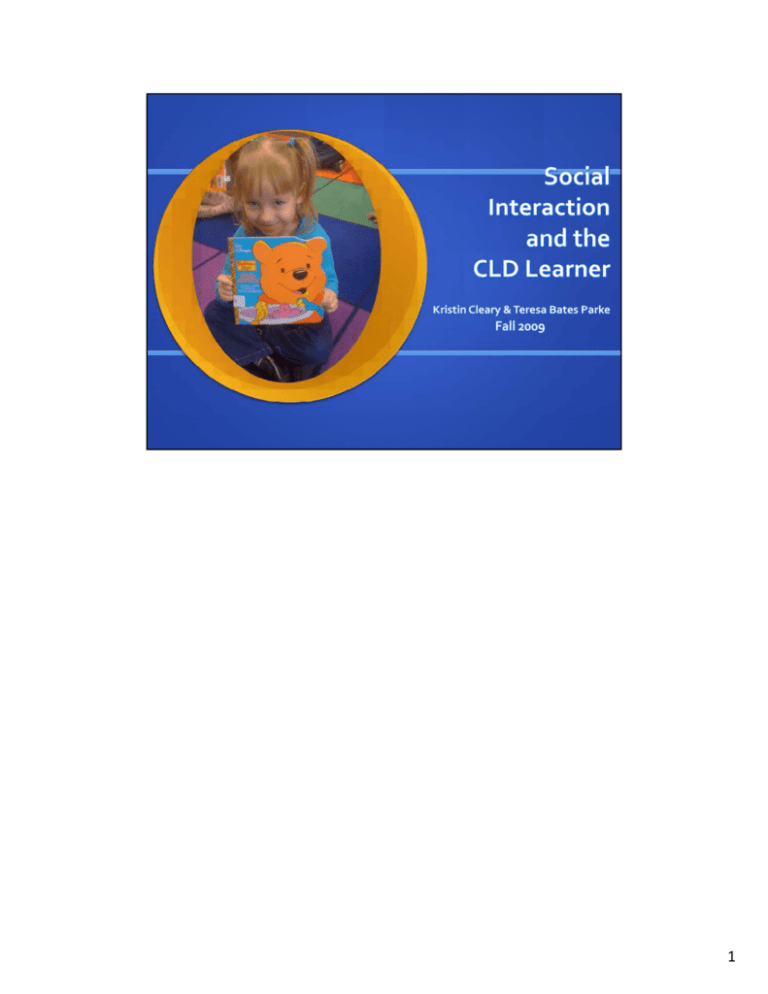
1 Constructing Learning Two heads are better than one! 2 We are going to introduce/remind you of the impact that social interaction has on the CLD learner. We will approach this by looking at theory, research and then hare with you practical ways you can implement Vygotsky’s Sociocultural Theory in your school, whether it be classroom or recess. 3 Although, we will be looking primarily at the work of Russian Psycologist Lev Vygotsky, we can’t speak to learning theroy without talking a bit about the “father” of Western Learning Theory, someone whom most of you will remember from your pre‐service education classes, Jean Piaget. Swiss psychologist, suggested that children go through four separate stages in a fixed order that is universal in all children. Piaget declared that these stages differ not only in the quantity of information acquired at each, but also in the quality of knowledge and understanding at that stage. Piaget suggested that movement from one stage to the next occurred when the child reached an appropriate level of maturation and was exposed to relevant types of experiences. Without experience, children were assumed incapable of reaching their highest cognitive ability. When information does not fit, the person must reexamine and adjust his thinking to accommodate the new information. Piaget described four stages of cognitive development and relates them to a person's ability to understand and assimilate new information. Sensorimotor: (birth to about age 2) During this stage, the child learns about himself and his environment through motor and reflex actions. Thought derives from sensation and movement. The child learns that he is separate from his environment and that aspects of his environment ‐‐ his parents or favorite toy ‐‐ continue to exist even though they may be outside the reach of his senses. Teaching for a child in this stage should be geared to the sensorimotor system. You can modify behavior by using the senses: a frown, a stern or soothing voice ‐‐ df b h b h f h all serve as appropriate techniques. ll h Preoperational: (begins about the time the child starts to talk to about age 7) Applying his new knowledge of language, the child begins to use symbols to represent objects. Early in this stage he also personifies objects. He is now better able to think about things and events that aren't immediately present. Oriented to the present, the child has difficulty conceptualizing time. His thinking is influenced by fantasy ‐‐ the way he'd like things to be ‐‐ and he assumes that others see situations from his viewpoint. He takes in information and then changes it in his mind to fit his ideas. Teaching must take into account the child's vivid fantasies and undeveloped sense of time. Using neutral words, body outlines and equipment a child can touch gives him an active role in learning. Concrete: (about first grade to early adolescence) During this stage, accommodation increases. The child develops an ability to think abstractly and to make rational judgements about concrete or observable phenomena, which in the past he needed to manipulate physically to understand. In teaching this child, giving him the opportunity to ask questions and to explain things back to you allows him to mentally manipulate information. Formal Operations: (adolescence) This stage brings cognition to its final form. This person no longer requires concrete objects to make rational judgements. At his point, he is capable of hypothetical and deductive reasoning. Teaching for the adolescent may be wideranging because he'll be able to consider many possibilities from several perspectives. According to Piaget parents and teachers have little impact on the stages of maturation except to provide the care necessary for children to be healthy (Woolfolk, 2005). 4 The modern understanding of mental processing of information was formulated many decades ago by learning psychologists such as Jean Piaget and John Dewey. However, the person who figured it out most clearly was Lev Vygotsky, a brilliant scholar who performed his research in Russia under the Soviet regime. He was born and worked at the same ti time as Jean Piaget, yet his his J Pi t t hi hi work was not translated and published in the west until about 40 years ago, due to k t t l t d d bli h d i th t til b t 40 d t political restraints. Soviet psychologist, Lev Vygotsky was a cognitivist, but rejected the assumption made by cognitivists such as Piaget that it was possible to separate learning from its social context. He argued that all cognitive functions originate in, and must therefore be explained as products of, social interactions and that learning was not simply the assimilation and accommodation of new knowledge by learners; it was the process by which learners were integrated into a knowledge community. According to Vygotsky: Every function in the child's cultural development appears twice: first, on the social level and, later on, on the individual level; first, between people (interpsychological) and then inside the child (intrapsychological). We will later explain to you how this is the earliest research on the gradual release of responsibility teaching method. This applies equally to voluntary attention, to logical memory, and to the formation of concepts. All the higher functions originate as actual relationships between individuals (p. 57). Vygotsky promoted a theory of cognitive development known as Sociocultural Theory. His position was “that human activities take place in a cultural setting and cannot be understood apart from these settings (Woolfolk 2005).” “Vygotsky yg y assumed that ‘every function in a child's cultural development appears twice: first on the social level and later y p pp on the individual level; first between people and then inside the child’(Woolfolk 2005).” In other words, cognitive processes are first constructed in a social, cultural setting between at least two people; those cognitive processes are then internalized by the child and become part of their cognitive development. Vygotsky did not view social interaction merely as an influence on a child’s cognitive development, but rather as the origin of higher mental processes such as problem solving. Parent/Child Example (Shoe Tying) Teacher/Student Example (Fluent Reading) Librarian/Student Example (Web Evaluation) 5 First, jot down what you see in this picture. Now, talk with your neighbor what you saw, and discuss their findings as well. Write down your final answer. 6 How many of you “changed” your answer thanks to your “think‐pair‐share” with your neighbor? Good! You have just experienced learning via social interaction. Like Calvin and Hobbes knew, two heads are better than one. Today’s presentation will further strengthen that theory for CLD students in our classrooms and school. Some people ‘see’ an aerial photograph, others detect the coat of a spotted cow, still others visualize the image of a face. Personally, I saw a wolf and my husband laughed thinking it was clearly an aerial photograph. Teresa then pointed out that the image looks like Jesus Christ. What each person ‘sees’ depends on what already happens to be stored in that person’s brain. Learning from our senses is, therefore, an active process. New knowledge is a mix of incoming information and prior impressions 7 Looking at Piaget before we get into Vygotsky will provide significant insights and contrasts for teaching CLD students. A primary reason is that an awareness of Piaget and his influence on how Western society has understood cognitive development for the past half century is key to sharing with colleagues how important it is to consider the influence of culture in cognitive development for CLD students. All too often CLD students are viewed as having only a language barrier with the assumption that the cognitive processes the CLD students have in place are the same as any other student. In the American school system, we are set up more like Piaget; grade levels, grade level tests etc. For our CLD student, having to learn a new language, their learning may not follow in that path. As educators, when our CLD students struggle in the classroom, we need to review our teaching practices and think more fluidly about our students learning development. It is likely that many of our fellow educators hold to Piagetian principles, perhaps not even realizing that the convictions they have about cognitive development are from Piaget. For that reason it is necessary to have some knowledge of Piaget, be ready to acknowledge the aspects of his theories that are valid and widely accepted, and be prepared to communicate how Vygotsky’s p y p , p p yg y Sociocultural Theory can be y extremely useful in working with CLD students. Jean Piaget was a Swiss psychologist who greatly impacted how educators understand cognitive development. His theories, while acknowledging the role of social interaction, do not place significant emphasis on culture. There are several reasons Piaget had a far greater influence in the West for several decades. One reason was that Vygotsky’s work was not readily available in English until relatively recently. Pieces of his work were published in English during his lifetime, but the few copies available were not widely read. One of his most important works, Thinking and Speech, g became available in English translation in 1987. A second reason Vygotsky was less influential in the West was that he died at only 37 in 1934 leaving his theoretical work in complete while Piaget lived to the age of 84. Finally, Vygotsky was working in the recently formed Soviet Union during a turbulent time in his country's history while Piaget was Swiss and faced no political challenges (Mahn, 1999). 8 Before we delve in further to the Socio‐cultural Theory, let’s take one last look at the contrast in cognitive development shaped by Piaget & Vygotsky. Unlike Piaget's notion that children's development must necessarily precede their learning, Vygotsky argued, "learning is a necessary and universal aspect of the process of developing culturally organized, specifically human psychological function" (Vygotsky,1978). In other words, social learning tends to precede (i.e. come before) development. 9 Culture makes two sorts of contributions to a child’s intellectual development. First, through culture children acquire much of the content of their thinking, that is, their knowledge. Second, the surrounding culture provides a child with the processes or means of their thinking what Vygotskians call the tools of intellectual adaptation. thinking, what Vygotskians call the tools of intellectual adaptation In short, according to the social cognition learning model, culture teaches children both what to think and how to think. 10 Vygotsky argues that a child's development cannot be understood by a study of the individual. We must also examine the external social world in which that individual life has developed...Through t l i th t l i l ld i hi h th t i di id l lif h d l d Th h participation in activities that require cognitive and communicative functions, children are drawn into the use of these functions in ways that nurture and 'scaffold' them" (Vygotsky 1978). Learning is embedded within social events and occurring as a child interacts with people, objects, and events in the environment (Vygotsky 1978) First, it is fundamentally cultural. Caregivers are agents of culture who set an infant's nascent actions within an intimate setting that is deeply informed by the caregiver's cultural knowledge. Caregivers cannot help but view infants' expressions as meaningful within the human sphere of their own culture. Infants, in complement, are quintessential cultural apprentices who seek the guided participation of their elders. Second, the notion of a zone of proximal development reveals a pattern of developmental change in which a phase of adult support precedes a phase of independent infant accomplishment Each in which a phase of adult support precedes a phase of independent infant accomplishment. Each cycle begins with a newly displayed behavior, such as a smile, a visually directed reach, or a babble. The adult's reaction and interpretations transform the infant's emerging behavior into a social act. In essence, the child induces the adult to recruit the act for communication.. After many experiences of supported expression, the child gradually masters an action that is qualified with cultural meaning. The act has passed through the zone of proximal development during which the adult has educated the child in its use. (Vygotsky, 1978) 11 A second aspect of Vygotsky's theory is the idea that the potential for cognitive development depends upon the "zone of A second aspect of Vygotsky s theory is the idea that the potential for cognitive development depends upon the Vygotsky's theory is the idea that the potential for cognitive development depends upon the "zone zone of proximal development" (ZPD): a level of development attained when children engage in social behavior. Full development of the ZPD depends upon full social interaction. The range of skill that can be developed with adult guidance or peer collaboration exceeds what can be attained alone. Vygotsky's theory was an attempt to explain consciousness as the end product of socialization. For example, in the learning of language, our first utterances with peers or adults are for the purpose of communication but once mastered they become internalized and allow "inner speech". •ZPD‐Vygotsky’s ZPD V t k ’ term for range of skills that a person can exercise with assisstance t f f kill th t i ith i t b ti but is not quite t it able to to perform independently •But the most significant bases of a social constructivist theory were laid down by Vygotsky. In his theory of the "Zone of Proximal Development" (ZPD). "Proximal" simply means "next". He observed that when children were tested on tasks on their own, they rarely did as well as when they were working in collaboration with an adult. It was by no means always the case that the adult was teaching them how to perform the task, but that the process of engagement with the adult enabled them to refine their thinking or their performance to make it more effective Hence for him the them to refine their thinking or their performance to make it more effective. Hence, for him, the development of language and articulation of ideas was central to learning and development. The common‐sense idea which fits most closely with this model is that of "stretching" learners. •It is common in constructing skills check‐lists to have columns for "cannot yet do", "can do with help", and "can do alone". The ZPD is about "can do with help", not as a permanent state but as a stage towards being able to do something on your own. The key to "stretching" the learner is to know what is in that person's ZPD—what comes next, for them. •For parents and teachers, this is a continual process as we teach children just what is beyond them. 12 Curriculum–Since children learn much through interaction, curricula should be designed to emphasize interaction Curriculum–Since children learn much through interaction curricula should be designed to emphasize interaction between learn much through interaction, curricula should be designed to emphasize interaction between learners and learning tasks. Instruction–With appropriate adult help, children can often perform tasks that they are incapable of completing on their own. With this in mind, scaffolding–where the adult continually adjusts the level of his or her help in response to the child’s level of performance–is an effective form of teaching. Scaffolding not only produces immediate results, but also instills the skills necessary for independent problem solving in the future. Assessment–Assessment methods must take into account the zone of proximal development. What children can do on their own is their level of actual development and what they can do with help is their level of potential development. Two children might have the same level of actual development, but given the appropriate help from an adult, one might be able to solve many more problems than the other. Assessment methods must target both the level of actual development and the level of potential development. 13 Classroom Implications •Vygotsky’s theories have helped teachers think about their role in the learning process. Multiple instructional strategies need to be used to create the ‘ZPD.’ •His learning theories benefit all students by encouraging teachers to think more about incorporating active learning in the classroom. ‐”According to Vygotsky (1962) learning depends on development, but development is not dependent on learning. Effective instruction can further development. Quality instruction then depends on the teacher being able to bridge the gap between the students’ current skill level and potential skill level. (Driscoll,1994) Teachers, then, need to be aware of where their students are in their development. (Vygotsky, 1962) •Its just good teaching! 14 •Teaching strategies are moving from teacher‐centered to student centered learning (Gibbons 2002) •The teacher must plan activities that bring together not only what students are capable of doing on their own but what they can achieve with the help of others. • These are not the ONLY areas where social interaction theory comes in to play, but most research highlights these three main topics. research highlights these three main topics. 15 Scaffolding: •Defined as: supportive behaviors by which an expert can help a novice learner achieve higher levels learning. It i th t It is the temporary assistance that a teacher gives to help the learner know how to perform a task, it th t t h i t h l th l k h t f t k so that the learner will then be able to complete a similar task alone. Vygotsky defined scaffolding instruction as the “role of teachers and others in supporting the learner’s development and providing support structures to get to that next stage or level” (Gibbons, pg. 10) •During scaffolding: 1. The ‘expert’ breaks the goals into smaller goals and directs the interactions 2. The ‘expert’ responds to the learner’s initial level of performance (R (Rogoff ff 1990) •In thinking about the classroom, it is temporary but necessary assistance by the ‘expert’ to assist the learner achieve a task. It is a directed form of assistance that helps a student move toward a specific skill, concept, or level of understanding. (Gibbons, pg 10) Think of a scaffold on a building, it goes up as the building is built, but it is only temporary and when the building is solid, it is taken down and the building stands on its own. •“I do it, we do it, you do it” ‐‐Teacher demonstrates, then does it with the students, then withdraws assistance as the students to it themselves i hd i h d i h l (NWREL pg. 8) Vygotsky has said that what a child can do with support today, she or he can do alone tomorrow. (Gibbons pg. 10) •For the ELL learners in the classroom, tasks should not be simplified, rather, teachers are challenged to provide the kind of scaffolding needed to help the novice learner to carry out a task. The support should reflect the student’s needs and this is critical for the individual to reach a higher potential. (Gibbons, pg.11) 16 Scaffolding: Bruner (1978) “A metaphor for a mother’s verbal efforts to maintain conversation with a child and, indirectly, promote language acquision” (Guerrero & Villamil 2000) Scaffolding is “according to Wood, Bruner and Ross (1976) tutorial interactions are crucial in fostering development in the human being. Scaffolding characterized by six actions: a) recruiting the tutee’s attention, b) reducing degrees of freedom in the task to make it manageable c) keeping direction in terms of the goals d) marking the critical features e) manageable c) keeping direction in terms of the goals, d) marking the critical features e) controlling frustration f) modeling solutions” (Guerrero & Villamil 2000) ‐Recruiting (and keeping the students’ attention)=Keeping the student motivated ‐Reducing degrees of freedom=breaking up a task in to smaller tasks, giving limited choices‐ simplifying ‐Keeping direction in terms of the goals=redirecting the student to the task ‐Marking critical features=Clearly indicate differences between the child’s work and the standard or desired solution ‐controlling frustration/risk ‐Modeling solutions=clearly define expectations •These actions seem intuitive to teachers (tutors) but as defined are specific to assisting students to achieve the next stage of learning. Tutors must then give effective feedback as students to achieve the next stage of learning. Tutors must then give effective feedback as the student proceeds with the task. The teacher’s job is then to manage the interaction between the task and the demands of the student. (Guerrero & Villamil 2000) 17 Modeling “think alouds”—providing clear examples of the work that will be required, demonstrating how to think through a problem Bridging/Activating Background knowledge Connecting new learning to prior learning (KWL charts)—What do you know? –prior to the lesson What do you want to know? –Prior to the lesson What did you learn?—after the lesson In reading‐seeing In reading seeing links between texts and their own experiences (text to self, text to links between texts and their own experiences (text to self text to text connections) Schema Building Using graphic organizers Use of manipulatives and real‐life objects Provides ‘comprehensible imput’— NWREL—Center for Research, Evaluation and Assessment **Reading and writing in authentic situations where students are engaged in purposeful and meaningful use of language—these authentic situations provides the activities where the ZPD is embedded (Dolittle) writing must be relevant to life must be relevant to life” Vygotsky (1978) Vygotsky (1978) “writing 18 Vygotsky’s ideas about the ZPD provide strong support for cooperative learning strategies to be included in classroom instruction 19 Cooperative learning has certain characteristics, it is more than just simply giving ‘seat work’ to a group to complete. Positivie Interdependence: Task success/goals depend on participation of all group members. Students will be more motivated to work when the collective success depends on all group members. For example, giving pennies or beans to students to put into a collective ‘pot’ to be sure that each person contributes an idea to the group. Another example: having collaborative group j , g p ‘jobs’ that rotate, as in science lab groups. Face‐to‐face interacion: group members provide feedback, help and assistance, influence each other to achieve mutual goals Individual Accountability: Each student is responsible for completing a task—no ‘freeloaders!’. For example, portions of a task can be given out to each student, and they earn points for it separately. Interpersonal Skills—Social skills are necessary for a student to perform in a group and these skills are taught during cooperative learning. Turn taking, listening and speaking, these skills are naturally a part of cooperative group learning. Group self‐evaluation: a process of evaluating the group’s own efforts toward group goals. For example groups can rate themselves on a 1‐2‐3‐4 rubric of how they worked together. (Doolittle, 1995) according to Johnson, Johnson, Hulubec & Roy (1984) Teacher Monitoring (added) Modeling appropriate group behaviors and monitoring these closely helps collaborative group time to be more effective 20 Positive Interdependence=Developmental Interdependence: The child’s development is dependent on interactions with other children and adults. The ‘expert’ assists the ‘novice’ to reach the ‘ZPD’. Interdependence is key to cooperative learning and linked to Vygotsky’s theory because of they way the ‘novice’ relys on the ‘expert’ for this assistance through a ‘joint’ problem solving and both are responsible for the task of learning. (Dolittle pg. 15) Face to face interaction=Social Mediation and Enculturation =Social Mediation is the acquisition of knowledge through interaction with others (pg. 15) “Enculturation refers to what is learned, while social mediation refers to how it is learned.” (pg. 16) h ti l d hil i l di ti f t h it i l d ” ( 16) Individual Accountability= Individual development—Each child is responsible for developing within their unique ZPD. Each member should grow and develop. Group social skills=Culturally‐based signs and tools—Dolittle states, according to Vygotsky, (1978) signs are the internal reasoning skills and tools are mechanisms for altering one’s environment (Vygotsky 1978 pg 55) Self‐Evaluation=Monitoring growth and development‐For Vygotsky part of instruction involves the constant monitoring of each student’s growth within their ZPD development (Dolittle pg. 18) 21 There are many opportunities for interaction through these strategies. Peer‐Assisted Learning: Partner reading –for example reading buddies with a fluent reader and a less fluent reader. Spelling Buddies, with students correcting each other’s pre‐tests. Instructional Conversations—Students discussing open‐ended question. "Instructional Conversation" is a methodology recommended for use with culturally and linguistically diverse learners (Tharp, 1997; Tharp & Gallimore; 1991). It is open‐ended talk in which ideas are explored ideas are explored. “Research indicates that the instructional conversation (IC) can be an effective method for raising the low academic achievement levels of various groups of Native American students” (Tharp, 1989; Tharp & Gallimore, 1988). Inquiry‐based methods‐ Conducting and planning investigations, gathering data, thinking about other solutions to problems. (NWREL) PLAY! Children’s imaginative play is significant in the process of socialization and development. In play, natural speaking and interactions take place. For interactive approaches to be effective they need to be structured and monitored. Modeling and ‘looks Modeling and looks like like’/’sounds / sounds like like’ charts can be used/collaboratively made by teacher charts can be used/collaboratively made by teacher and students through mini‐lessons that are used to identify behaviors and learning expectations. (Miller, 2002) 22 Static vs. Dynamic assessment: Static testing—limited to student’s current performance level‐‐‐ used for prediction of performance (Kozulin & Garb 2002) Dynamic—developed by Budoff and Fiedman (1964) and Feuerstein (1979) includes a mediated learning phase which provides a better insight into students’ learning capacity than unaided performance Vygotsky suggests charting the student Vygotsky suggests charting the student’ss performance alone vs. assisted. Interactive performance alone vs. assisted. Interactive interventions such as leading questions, modelling, starting a task and having students finish are a part of what he suggests for assessing a student’s ZPD. (Kozulin & Garb 2002) 23 DIBELS testing –”Dynamic” Indicators—Has the test, intervention, retest format 24 25 26




